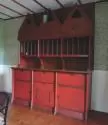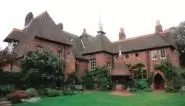From Victorian to Vernacular
 This is Part 2 of a series written by Cynthia Shaw for the Colorado Arts & Crafts Society. To read part one, please click here.
This is Part 2 of a series written by Cynthia Shaw for the Colorado Arts & Crafts Society. To read part one, please click here.
In July of 2013, I attended the 39th Annual London Summer School sponsored by the Victorian Society of America. Founded in 1974 by the renowned architectural historian Sir Nikolaus Pevsner, the two-week study program is an intense immersion into the architecture, interior design, decorative arts and landscape of the hub of late 19th century England.
While it might seem odd that any long-time devotee of the Arts and Crafts movement would elect to sign up for a two-week course focusing on its antithesis, for me it was an opportunity to study the historic context that pushed William Morris and others to take a leap of faith into a burgeoning design world that melded age-old medieval traditions with a modern-day philosophy.
Disembarking from an overnight crossing of “the pond” via British Air, I headed straight from Heathrow to our headquarters: the Tavistock Hotel in Bloomsbury. There in the lobby, our “den mother”, Elizabeth Leckie, greeted all 21 of us (19 Americans, an Australian and a Hungarian). After checking in with our assigned roommates, we set off…on a lightning-quick pace that did not slow down for the duration of the course.
That afternoon, after a formal welcome and introductions at the Art Workers’ Guild, we met Course Director Ian Cox, heard a couple of inaugural lectures and enjoyed our first afternoon tea. Then we took a walkabout around Bloomsbury with Alan Crawford (best known for his books on C.R. Ashbee and Edward Burne-Jones) before sitting down to a group dinner back at the hotel.
Our first full day began at the bustling St. Pancras International Station, followed by a lunchtime traipse through the Columbia Road Flower Market and a tour of the period rooms and gardens at the Geffrye Museum. Finally, it was time to board the bus for one of the high points of the program: our long-awaited pilgrimage to the iconic Red House in Bexley Heath, designed in 1859 for William Morris by his long-time friend Philip Webb. Following Morris’s request to “build (me) a house very medieval in spirit”, the red brick dwelling was later described by Burne-Jones as “the beautifullest place on earth” and by Dante Gabriel Rossetti as “more a poem than a house.”
Significant as the only house Morris ever built and as Webb’s first independent work, the Red House epitomized their shared Pre-Raphaelite ideas about architecture, art and life. The challenge of properly decorating the interior inspired the 1861 founding of the design firm of Morris, Marshall, Faulkner & Co. Issuing its own line of Gothic-inspired furniture and other accoutrements such as stained glass, textiles, tiles and wallpaper patterns evocative of the flowers planted in the Morris family garden, the company was an overnight success with wealthy clients who could afford to purchase its merchandise.
E njoying a happy bohemian existence for five years with his wife Jane Burden, their two daughters and many friends and visitors (attended by four live-in servants), in 1865 a series of unfortunate circumstances forced Morris to return to London, abandoning his beloved haven and his dream of creating a colony there for like-minded artisans. While the once-bucolic setting has been replaced by urban sprawl and most of the furnishings are long gone, fortunately the Red House was cherished by its later owners and finally acquired by the National Trust in 2003. Having keenly observed the painstaking stewardship practices and experienced the pervasive spirit of fellowship all around us, no Arts & Crafts comrade could ever forget this fine field trip.
njoying a happy bohemian existence for five years with his wife Jane Burden, their two daughters and many friends and visitors (attended by four live-in servants), in 1865 a series of unfortunate circumstances forced Morris to return to London, abandoning his beloved haven and his dream of creating a colony there for like-minded artisans. While the once-bucolic setting has been replaced by urban sprawl and most of the furnishings are long gone, fortunately the Red House was cherished by its later owners and finally acquired by the National Trust in 2003. Having keenly observed the painstaking stewardship practices and experienced the pervasive spirit of fellowship all around us, no Arts & Crafts comrade could ever forget this fine field trip.
For more information on the Colorado Arts & Crafts Society, please visit coloarts-crafts.org.

